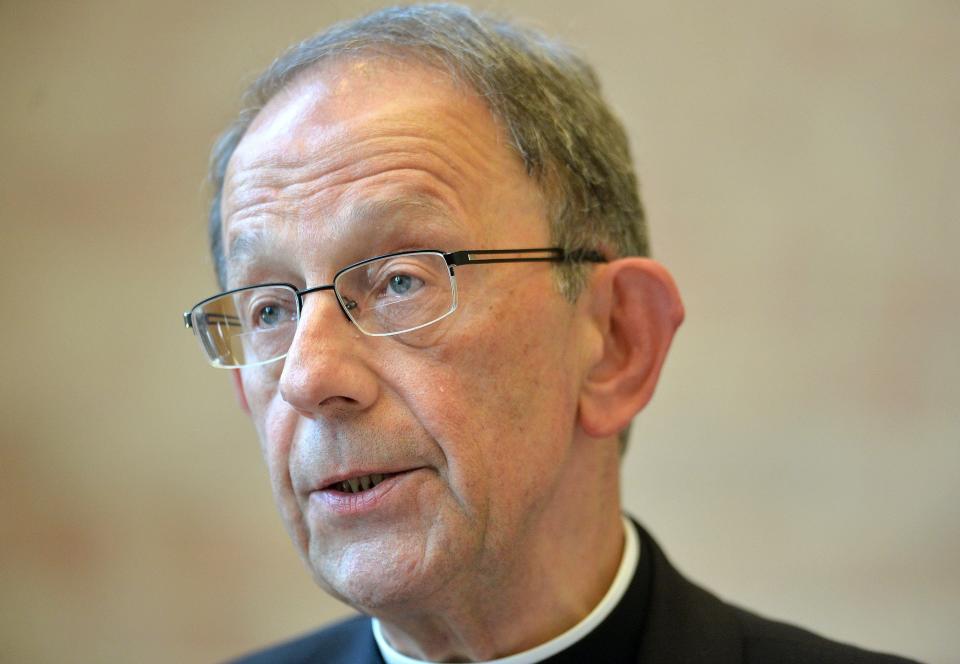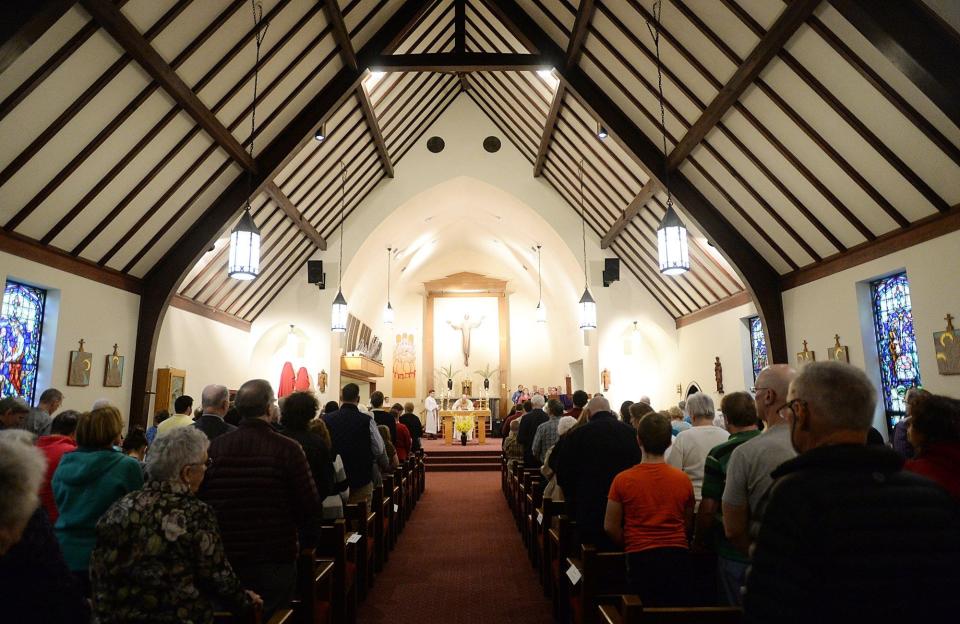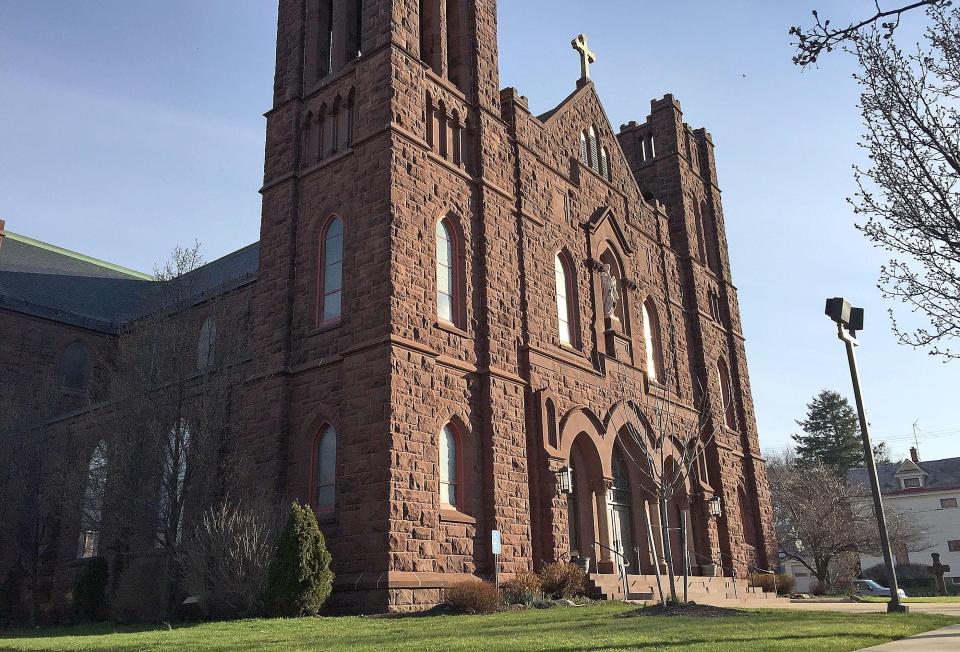Catholic Diocese's final restructuring plan for Erie County parishes includes mergers, partnerships
Erie Catholic Bishop Lawrence Persico expects to ordain one new priest this year and two in 2025, followed by three years with no ordinations.
During that time when the Catholic Diocese of Erie won't be adding new priests, it will have 16 of its now 93 active priests reach the retirement age of 75. The number is already down from 120 active priests in 2015.
The declining number of priests is one reason the Catholic Diocese of Erie began its latest parish restructuring planning. A preliminary proposal for Erie County was released in August with the final plan announced Thursday. The new configuration goes into effect July 9 and will reduce the number of Roman Catholic parishes in Erie County from 33 to 27. It also has some significant changes from what was proposed in 2023.
"The preliminary plan that came out in August was very aggressive," Persico told the Erie Times-News on Friday. "But, in reality, after we got feedback, it's not going to work."
One thing Persico said he realized was there were priests who already had multiple full-time jobs, such as parish pastor and teacher or administrator. He said he couldn't give them another parish as a partner.
"I didn't want to kill them," he said. "They're hard to come by."
Persico said another option is to eventually look at having international priests from other countries come into the Erie diocese.
But in the meantime, it will go forward with a revised restructuring.
The number of parishes that won't experience a change has more than doubled from the 2023 proposal while the arrangement of parishes that will merge and/or partner has shifted.
In just one example of how the final parish plan differs, the proposed version had St. Joseph Bread of Life in Erie merging into St. George in Millcreek Township and had Sacred Heart and Blessed Sacrament, both in Erie, partnering. The final plan has St. Joseph partnering with Sacred Heart while St. George and Blessed Sacrament will have no changes.
“As we move into new configurations, we have an unexpected opportunity to renew our parishes, ensuring they are life-giving places of worship, places where people find encouragement and inspiration as they grow in their relationship with Christ, his church and each other,” Persico said in a news release. “That is really the only goal we have. To grow in our faith. To grow closer to Christ. And to help each other along the way.”

The Rev. Nicholas Rouch, vicar general for the diocese, said in the release that the decisions were driven by data including Mass attendance, priest availability, church capacity, distances between churches and parish indebtedness.
Attendance at Roman Catholic Masses in Erie County declined by 45% between October 2010 and October 2022, according to information from the diocese. It reported that 22,187 people were counted at Masses at Erie County parishes in October 2010, there were 18,461 counted in October 2015 and the number dropped to 11,232 in October 2023.
Rouch said there will need to be a review of Mass times at the churches, especially now that some priests will be pastoring partnered parishes. A partnered parish has its own members, parish church, finances and finance council but shares a pastor, parish pastoral council, office and staff with another parish.
Persico said that once the dust settles, he wants pastors in the City of Erie in particular to look at their Mass schedules and "do what's necessary, not what's nice."
"We have almost 90 Masses in the City of Erie," he said.
Here is the final restructuring the diocese announced Thursday:
Parishes without changes
Seven Erie County parishes weren't expected to experience change, according to the proposed plan. One, St. James in Erie, was removed from that list and another nine were added to the list of "parishes that will not experience change at this time" in the final plan.
The original seven are: Holy Cross in Fairview, Our Lady of Peace in Millcreek Township, St. Gregory in North East, St. Julia in Erie, St. Patrick in Erie and St. Peter Cathedral in Erie.
The additional churches are: All Saints in Waterford, Blessed Sacrament in Erie, Our Lady of the Lake in Edinboro, Our Lady of Mercy in Harborcreek Township, St. Boniface in Greene Township, St. Francis in McKean, St. George in Erie, St. John the Evangelist in Girard, and St. Lawrence the Martyr in Albion and its secondary mission church, St. Philip in Crossingville.
Mergers
The preliminary plan outlined seven mergers of parishes. The final plan has two but also includes a separate list of churches that will partner and merge.
Merging is explained by the diocese as bringing two parish communities together into a single entity. One parish is subsumed into another, creating one parish from two.
A stand-alone parish is a single community of believers with their own pastor, parish church, finances, finance council, parish pastoral council, staff and office.
A parish church is the principal church of a parish while secondary churches are one or more other churches in a parish that don't have a weekend Mass but can be used for wedding and funerals and possibly a weekday Mass. A secondary mission church has permission for Mass on Sunday mornings or Saturday evenings.
The Erie County mergers are:
Merge St. Mark the Evangelist Parish in Lawrence Park Township and Mount Calvary Parish in Erie into St. James Parish in Erie. St. James will remain a stand-alone parish church while St. Mark will become its secondary mission church and Mount Calvary will become its secondary church. St. Mark and Mount Calvary are currently partner parishes and the proposed plan had them merging into Our Lady of Mercy Parish.

Merge St. Teresa of Avila Parish in Union City into St. Thomas the Apostle Parish in Corry. St. Thomas will remain a stand-alone parish while St. Teresa will become its secondary mission church. Our Lady of Fatima, currently a secondary mission church of St. Teresa, will become a secondary church of St. Thomas. St. Thomas and St. Teresa are currently partner parishes.
From August: Erie County Catholic parishes would merge, partner under preliminary plan from diocese
Partnerships and mergers
A dozen parishes will become part of partnerships and mergers under the final plan. They are:
Partner Holy Trinity in Erie and St. John the Baptist in Erie and merge Holy Rosary in Erie, which will become a secondary mission church of St. John.
Partner Our Mother of Sorrows in Erie — which includes the parish church of St. Casimir and the secondary churches of Holy Family and St. Ann — and St. Stanislaus in Erie, which already has St. Hedwig in Erie as a secondary mission church for the Latin Mass Apostolate.
Partner Sacred Heart in Erie and St. Joseph Bread of Life in Erie and merge St. Paul in Erie, which will become a secondary mission church of Sacred Heart.

Partner St. Jude the Apostle in Millcreek and St. Stephen in Erie and merge St. Andrew, which will become a secondary church of St. Jude.
Partnerships
Four parish partnerships had been proposed. The one remaining in the final plan without a merger or other change is:
Partner St. Luke in Erie and Our Lady of Mount Carmel in Millcreek.
No closures, yet
The final plan doesn't close any Erie County churches, which are the buildings, but Persico didn't rule out that possibility. He said it would depend on a parish's ability to pay its expenses and keep up building repairs.
In order for a church to close, the pastor and parish council would need to notify Persico that the parish could no longer sustain the building. He could then relegate the church to profane but not sordid use, meaning the bishop removes the blessing or consecration of the church building and it ceases to be reserved for divine worship and can be used for non-religious purposes. The building could then be sold.
From 2020: Effects of parish restructuring are still playing out across the Catholic Diocese of Erie
The entire Catholic Diocese of Erie completed a pastoral planning process in 2017. It included church mergers and partnerships throughout the diocese. The plan unveiled Thursday was just focused on Erie County but similar work has already been done in several other geographical areas of the 13-county diocese.
"What we have to realize is the diocese is a living entity," Persico said Friday. "Like any living entity, it changes and has to adapt. We will continue to have to make changes as we move along. It's not status quo. Those days are over."
Dana Massing can be reached at dmassing@timesnews.com.
This article originally appeared on Erie Times-News: Erie County Catholic parishes to merge, partner under restructuring plan

